
Help via Ko-Fi
WHEN we speak of science in relation to crime, we usually think of scientific instruments and methods used by the police to capture and convict a criminal. We are apt to overlook the fact that there is nothing to prevent the intelligent criminal using all the resources of science in his battles with the law, and that he is not handicapped by red-tape nor officialdom, such as often exists in police organizations. We are apt to forget that the criminal, while mentally unsound in a larger sense, may possess an extremely fertile brain and brilliant talents. Before a particular branch of science can be applied to the detection of crime, police authorities must be consulted, permission must be obtained from various officials, appropriations must be submitted, passed upon, and approved: in fact, the machinery of justice and police work is too often slow moving and conservative.
The criminal is handicapped by none of these things. If he wishes to employ science in the perpetration of a crime, all he has to do is to purchase the necessary equipment, and USE it. Moreover, for each advance made by the police, the criminal can make two or more, without hindrance by any official redtape. Just how far crime-land has accepted science as an essential element in its battle against society, is described in the following article.
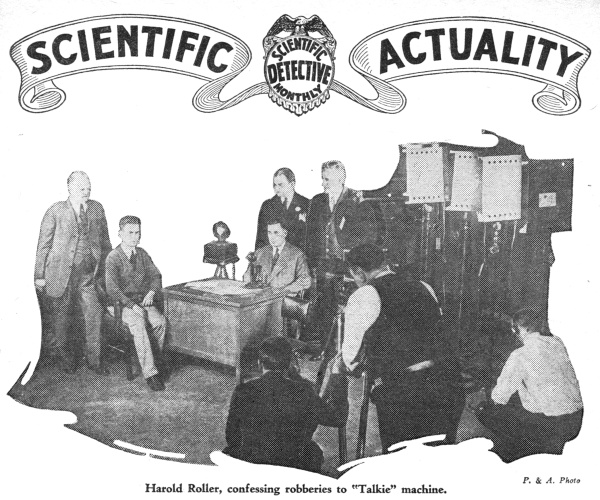
Science, the Police and the Criminal
By Ashur Van A. Sommers
WHEN Hermann Oberwader, professional safe-cracker and hold-up artist, nosed his way stealthily through the offices of the Mengel Jewelry Company, he had no presentiment of danger. The "cop" on the beat had been "attended" to, the janitor of the building lay unconscious and bound in the basement, and there were five clear hours ahead of him in which he could work slowly and methodically, short circuiting the standard burglar alarms attached to the massive safe, whose door was lighted by the usual single electric lamp, which is kept burning before safe doors to allow regular inspection by watchmen or policemen as they peer through the glass windows cut in the doors of offices for that purpose.
As Oberwader knelt before the safe and laid out his professional tool-kit, he could not know that the innocent electric lamp had actually detected his presence, and, in conjunction with its ally, a selenium cell, was at that moment informing Police Headquarters of his attempted burglary.
Thus science anticipates crime as well as detects it. Because Oberwader's body interrupted the beam of light that was thrown by the lamp onto a selenium cell concealed in the wall, an electric current passing through the cell was cut off, thus releasing a switch that sent an alarm to Police Headquarters. For selenium is a conductor of electricity only in the presence of light and the safecracker's shadow on the cell instantly lessened its conductivity, reducing the strength of the current that passed through it in series with a small electro-magnet. When the current was switched off from the latter, it released a soft-iron armature which sprang back against two electric contacts, thus completing the distant circuit which sounded the alarm in the Police Station. So Hermann was interrupted by several burly patrolmen long before he had solved the problem of opening the safe.
Such a device was recently demonstrated at the exhibition of the Physical and Optical Societies at the Imperial College of Science and Technology, South Kensington, England. A photograph of this demonstration is reproduced on the next page. When the ray of light from the lamp to the cell is broken, the detector will either communicate directly to the police, or will sound a local alarm, automatically recording the time of its break on a specially constructed clock.
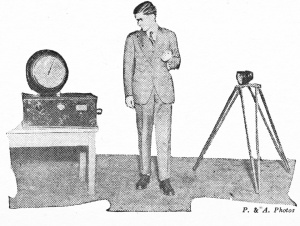
Science Defeats Science
AS we have related, the safe-cracker who was caught by this device went to jail. But the triumph of detective science was short lived. For hardly a week had passed before a fellow workman or craftsman of Oberwager walked into the same jewelry concern, stayed there a few hours, and walked out with a pocketful of diamonds. Knowing that a shadow cast by his body would break an electric circuit, all he had to do was to carry his own electric lamp and as he walked past the spot where the selenium cell would likely be hidden throw his own light in that direction. In fact, all that the second burglar had to do was avoid throwing a shadow when he intercepted the telltale beam of light. This he did by carrying his own lamp and using it when necessary.
But this is only a minor incident in the general warfare between the Law and the Criminal. We have read a great deal recently of the radio patrol wagons and police cars employed by Police Commissioner Rutledge in Detroit, Michigan. This, up to the present date, has proved a most effective method of preventing crime, or capturing a crook within a few seconds after he has perpetrated a robbery or murder. All police cars are fitted with radio receivers which are permanently tuned in to a broadcast station at headquarters. An idea of this latter station may be obtained from one of the photographs which shows two New York patrolmen operating such a station. As Patrolman Riggs listens to the call for help, his companion, Patrolman St. Jacques broadcasts the alarm over the air. New York is not yet as far ahead as Detroit in this system.
As the police cars cruise around the city in their appointed precincts, they are constantly in touch with Police Headquarters. More over, they report regularly from designated stations, so as to assure Headquarters of their being on the job, and that they have not been attacked by gangmen. The efficacy of this method may be illustrated by a case in Detroit, in which a hold-up man entered a house near Cass Avenue. A passerby, seeing a flicker of light against the wind ow pane, telephoned into the Police Station just on chance that something might be wrong. The alarm was broadcast, picked up by a police car cruising around within two blocks of the house, and the burglar captured within 12 seconds after the alarm was sent in by the passer-by.
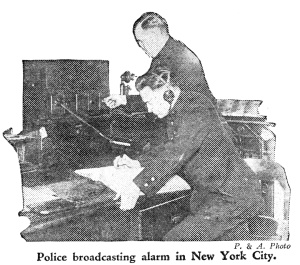
In another case, a man was captured after murdering his fellow gunman, even before he had time to throw away his gun. "Split-second arrests," Police Commissioner Rutledge calls them, and indeed, it looked for some time as if the criminal was at last limited "in his activities. whose Police Broadcast system is second to none, found itself completely disorganized the other day when a gang, bent on a series of robberies, constructed their own broadcast station, tuned in on the police wavelength and blotted out the latter entirely, so that no understandable orders could be broadcast to the police cruisers. Again criminals had "gone the police one better" in the employment and application of science.
How do criminals cooperate to use science in their work? We must remember that criminals, professional criminals, regard their operations just as a bricklayer or an accountant regards his profession. It is believed that in the London case, a band of ordinary safecrackers and burglars had engaged the services of an experienced radio-mechanic, who had inadvertantly slipped into some small criminal misdeed. Giving him a large salary, they employed him just as the police employ experts in the various sciences in the detection of crime. Operating under one executive mastermind, a series of burglaries, robberies of diamond merchants and fur stores had been planned out in advance, and notice given to affiliated gangsters that on the payment of a fee, they would be told the time and night on which the police radio would be put out of commission.
Criminal Radio Experts
ALL the robberies took place on the same night, the London police cruisers wandering around the streets wondering what had gone wrong with their receiving sets. Naturally, it was first imagined that unprecedented static was interfering with their radios; only after the reports of the robberies came in next day, did the police authorities discover that crime-land was alive to science and scientific methods and the value of organization. We must confess that the police are finding some difficulties with two more inventions. One of these is the lie detector. We illustrate this apparatus being used on E. Drew Clark, when he was on trial for the asserted murder of George E. Schick in San Diego, in the notorious Schick disappearance mystery. At the time, this machine was loaned for the purpose by the Los Angeles Police Department. One of the foremost exponents of the lie detector in this country is August Vollmer, now of the Chicago University, Chair of Criminology. Most of his work was performed in Berkeley, California, where he has a record of many successes.
But judges and juries are prejudiced against. the use of the lie detector, and also against the use of the motion picture record of a confession. It was thought that with the use of the Talkie in recording confessions, police methods would be changed, and a rogue's gallery of talking films be brought into court at trials. We show a photograph of Harold Roller, a milk wagon driver, whose confession to 21 house robberies was made into a -"talkie" by the Philadelphia police. In the group shown, are, left to right, Lieutenant of Detectives Benz, Roller, the prisoner, Inspector of Detectives Connelly, Director Schofield, and Superintendent of Police Mills.
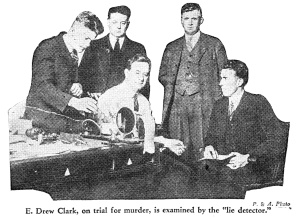
Beating the Lie Detector
BUT even as the lie detector comes into greater usage, criminals are anticipating its employment and preparing methods to "beat the game." The lie detector,'as we know, depends upon emotion reactions of a prisoner to questioning, these reactions being detected by changes in heart action and glandular action. The criminal, so long as he was ignorant of operation of the machine, could be easily trapped into incriminating reactions. But now he simulates fear, holds his breath, increasing the percentages of carbon dioxide in his blood and stimulating his cardiac reactions and respiration, and generally draws a red-herring across the trail of truth.
My object in writing this article, is to demonstrate to both police and public, that science is equally at the service of the criminal and the police, and that it is not entirely impossible that the former may outstrip the law unless a definite program of advancement is arranged, and the dangerous potentialities of science in the service of the criminal, acknowledged and prepared against.
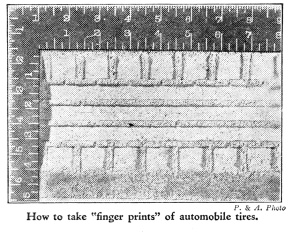
Recently a new bureau of scientific criminology has been established to identify automobile bandits. This has been innovated by Dave Chapman and Captain Norris Stensland, of Los Angeles, California. Photographs are made of tire impressions and then, with rule and calipers, careful and exact measurements are taken of the tire-prints. Finally a composite of both factors is made, manifesting the type of tire, the kind of car on which it fits, and possible ownership. An extensive file and records of all makes, patterns and sizes of tires used are kept at headquarters. One of the photographs shows a "finger-print" of a tire tread, labelled and identified.
But there will be no millennium in this fight along the borders of crime-land. It is a perpetual race between the policeman and the criminal, and victory goes to the one who keeps ahead in the application of science in all its branches.
THE END